Select route
Related POIs
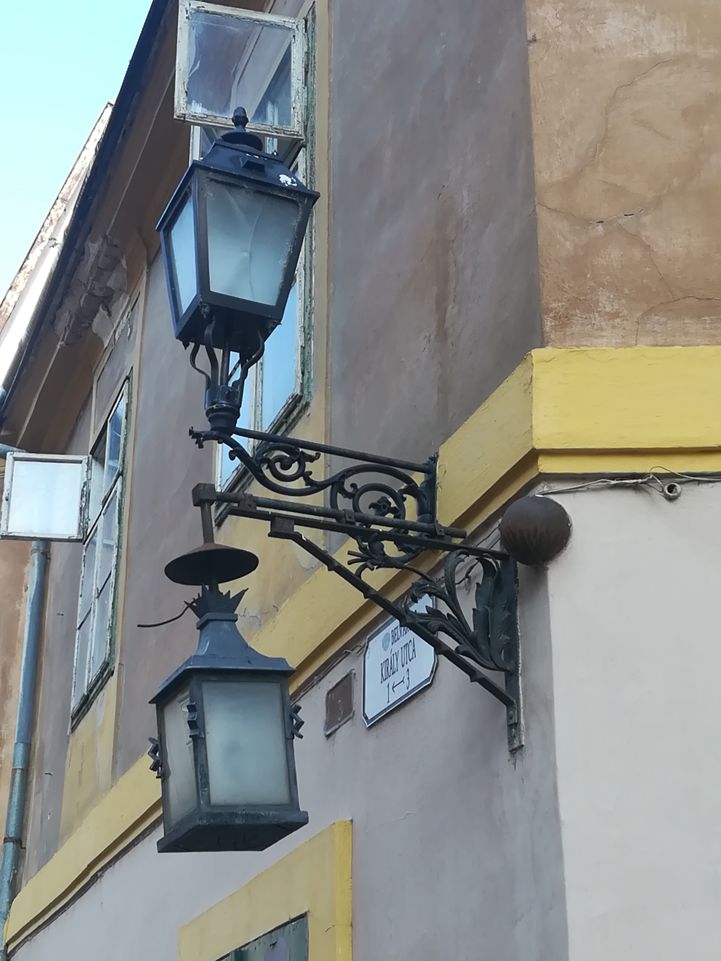
Napoleon's cannonball
The town of 130,000 inhabitants is one of the largest in Hungary. It has a fortunate location at the mouth of the Mosoni-Danube, the Rába and the Rábca rivers, therefore it is also known as the "city of rivers". A major economic, cultural, academic and sports centre, it is one of the most dynamically developing cities in Hungary. One of the most interesting periods of its colourful and rich history was the Napoleonic Wars in the 19th century. In the January-February 1873 issues of the Győri Közlöny newspaper, there was a debate about whether Napoleon had really visited Győr. The question finally ended with the certainty that he did, and in that year a memorial plaque was placed on the façade of the Napoleon House, which reads: 'Napoleon I stayed here on 31 August 1809' in Hungarian. War between Austria and France broke out on 10 April 1809. Napoleon marched into Vienna a month later and issued a proclamation to the Hungarians, calling on them to break away from the Habsburgs and elect a national king. He had done the same in Spain and Poland earlier. As it turned out there, he had no real intention of giving these nations real autonomy. He put his own relatives and confidants in the real positions of power. Nor did his attempted incitement of the Hungarians against Austria stem from the fact that he had the interests of the Hungarian nobility at heart. He followed the principle of "divide et impera" (divide and rule), which had been well established for thousands of years, to keep the Austrian Empire between two fires. The Hungarian nobility knew exactly what was at stake and what they could expect after the Spanish and Polish examples. Hungary was on Austria's side, and the armies that the nobility were obliged to send were massed in Győr. Following Austria's declaration of war, Western Hungary became a military staging area. A number of factors contributed to the Austrian-Hungarian army's retreat at the Battle of Kismegyer on 14 June 1809: the imperial army, in poor condition and made up of peasants, the disorganised, hungry Hungarian nobility forces, lack of supplies, inexperienced decision-makers who were not sufficiently aware of the military situation, and court intrigues. But why did the emperor come to Győr? The purpose of his visit was to see and assess the local fortifications, battlements, bastions and defensive lines. According to records of the time, he arrived in a six-horse carriage through the Bécsi-kapu (Vienna Gate), accompanied by his high-ranking officers. All the bells of the city were rung for his arrival. It is said that he dined with his interpreter, the lawyer András Lehner, who spoke seven languages, and his family at the Fehérló (White Horse) Hotel. The place was owned by Lehner's father-in-law. Napoleon could not be too careful, and before he had consumed what was on offer, Lehner's wife and young son were promoted to imperial tasters. Legend has it that he also had time for fun, as it was obligatory for the whole town to celebrate his fortieth birthday which was two weeks before his arrival. But the revelry was too loud, and the monarch, disturbed from his night's rest and a man of a sudden temper, threw a cannonball he had just come across out of the window to show his displeasure. The iron ball embedded in the wall of the house opposite Napoleon House has been a memento of the conquering emperor's visit ever since, while the name of Győr – in the form of Raab – is also engraved on the Napoleonic triumphal arch in the section on victorious battles.
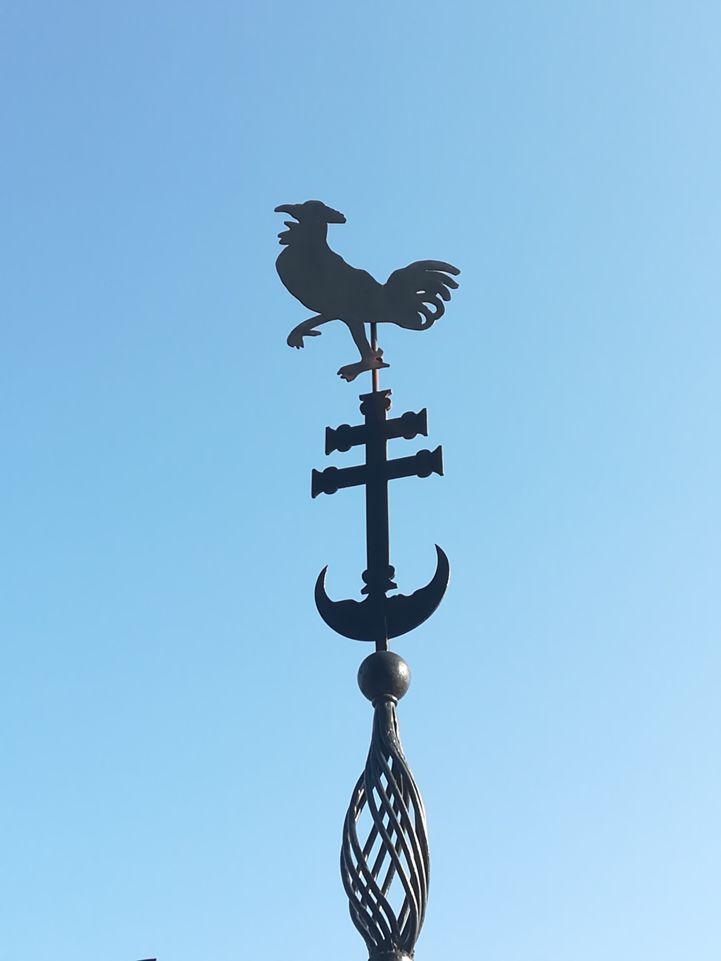
Crowing Iron Rooster
The oldest symbol of Győr is the crowing iron rooster, the oldest record of which dates back to 1598. In that year Győr was liberated from Turkish occupation. When the enormous Ottoman army occupied the town in 1594, the Turkish crescent and a copper windcock were placed on the tower of the bastion in the centre of the main square. These let the world know who ruled the city. All people in Győr know the story when the ambitious and no less arrogant Grand Vizier Sinan is said to have exclaimed: 'When this copper cock crows and the crescent under the cock is full, then the Hungarians will take back Győr'. The inventive and smart soldiers of Győr were just waiting for the opportunity to make their prophecy come true. On a moonless night in late March 1598, a few braves dressed as Turkish soldiers arrived at the Fehérvár Gate with their novel explosives. The moment had arrived! A bloody battle took place in the streets and the Turks were once again victorious. At one point, a local, resourceful shoemaker took the initiative, climbed up the Danube Bastion and started crowing. The Turkish warriors, who had lifted their heads, saw the rising sun complete the moon's crescent. That was all for the superstitious Ottomans, they fled Győr without touching the ground. Besides the crowing ore-cock and the brave shoemaker, this story also has heroes with names. When Győr was besieged by the army of Grand Vizier Sinan in July 1594, the settlement's castle was one of the most modern and strongest in the country. The castle was defended by Ferdinand Hardegg, who had already proved his prowess a year earlier when he and Miklós Pálffy defeated the Pasha of Buda at Pákozd. Archduke Mátyás, high in rank but low in military talent, rushed from Esztergom to the aid of Győr, but when the Turks attacked his disorganised and undisciplined armies, he fled with them. Lacking his support – to prevent further bloodshed – Hardegg surrendered the castle to Sinan, and Turkish rule began in Győr. Someone had to pay for the loss of this important strategic base: Hardegg was made a scapegoat and executed. We know from contemporary sources that the Turks were constantly short of food and raided the region, attacking larger food supplies. They led a life of gluttony and this resulted in their undoing. The words of the Turkish historian Ibrahim Peçevi also tell how Miklós Pálffy and Adolf Schwarzenberg succeeded in reconquering the city: "The people began to drink so much that there was not a sober man to be found among them. For this reason the walls were not guarded. Even the gatekeepers did not sleep at the gates. One night the cursed Pálffy gathered some thousand footmen, and came with one or two thousand horsemen himself. He hid the wooden cannon and did not even show it to his own soldiers, so they brought it to the gates of Győr. Through the carelessness of our governors, the gates of the castle, made of a few pine boards, were closed, but neither the drawbridge was raised nor otherwise blocked. Some apostate infidels came to the gate at midnight, shouted for a guard, and the wooden cannon was brought near. Upon questioning the guard, they lied that they had brought food from Pécs, and the guard ran off to get the key. They were eventually attacked. During the exchange, they brought the cannon close at will and fired it. As soon as the gate was broken down, the thousands of cursed men present went into the castle. Inside the castle, some lay drunk, others drugged with opium. As soon as they heard of the accident, the infidels were attacked from two sides, and once they were almost driven out. But the enemy was many, and these were careless. Behold, a strong fortress thus fell into the possession of the enemies of the faith."
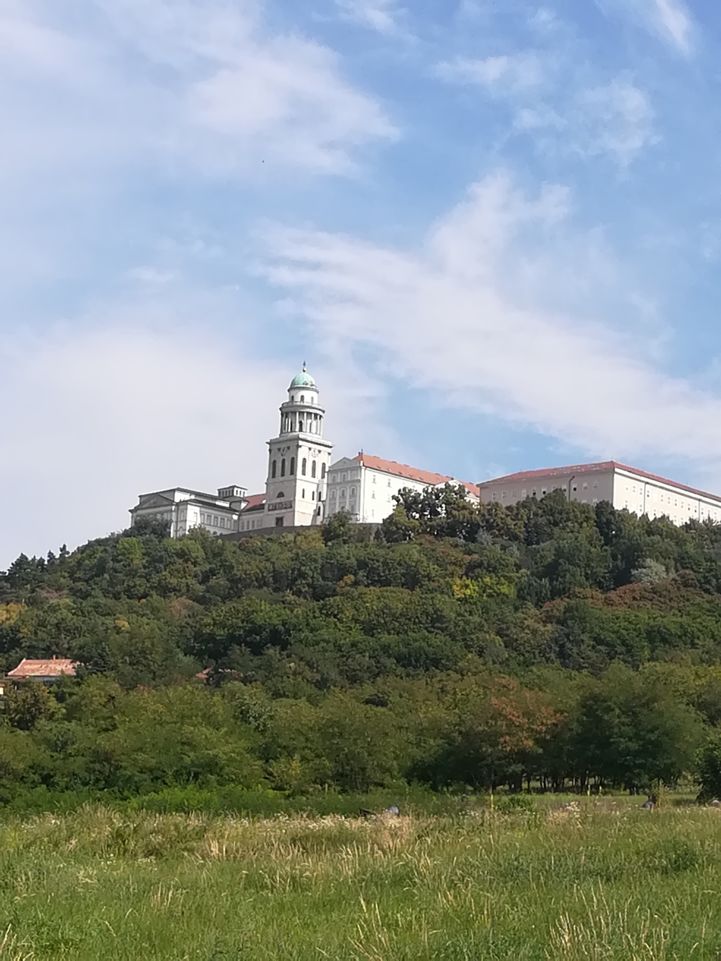
The Benedictine Archabbey of Pannonhalma
Pannonhalma, a town of 3600 inhabitants, was built at the foot of the Benedictine Archabbey. Its roots can be traced back to Roman times. In the 9th century, the conquering Hungarians found Avar, Slavic and Bavarian settlements in the area, which were familiar with Christianity. By the 10th century, the mansion of Hungarian princes stood on the hillside. The Benedictine Archabbey of Pannonhalma was founded in 996 and has been a monastery of St Benedict ever since. The abbey is one of Hungary's outstanding historical sites and a centre of ecclesiastical and artistic history. Today, it is home to a permanent community of about 40 monks who welcome retreatants, run a residential high school, and carry out cultural work: they run a world-famous library, archives, museum and publishing house, and organise concerts. They also work on the financial basis of the abbey's operations, including winemaking, brewing, a herb garden and hospitality. The spectacular complex of buildings of the Archabbey is built on the Szent Márton Hill, almost 300 metres high. The Romanesque altar church and the Gothic basilica have been supplemented over the centuries with Baroque and Neoclassical elements. These define the present-day appearance of the Archabbey. The whole complex is crowned by one of the most famous works of Hungarian Classicism, the 55-metre-high tower. The 19th-century library hall has a collection of 400,000 books, containing a number of rare books. From the very beginning, the Benedictine Archabbey of Pannonhalma has carried out pastoral work, reporting directly to the Pope. The Abbot, or Archabbot, of Pannonhalma has therefore been responsible for filling the pastoral posts on the Abbey's estates with parish priests for over 1000 years. This situation has changed since 1950. The life of the Benedictine community is defined by the triad of prayer, work and spiritual reading. The celebration of the liturgy plays an important role: the monks' day is marked by the liturgy of the prayer hours and the liturgy of the Eucharist. Reading the Scriptures and individual prayer also play an important role in the life of the monks. The secular activities of the abbey also follow the traditional Benedictine tradition. Herbs from the farm are used to produce essential oils, herbal teas and liqueurs, and grapes are used to make wine suitable for masses. The catering of travellers and pilgrims has evolved into today's catering, which is now mainly based on serving tourism. In addition to accommodation, visitors can find a restaurant, a cellar, a brewery, a café and shops selling local products. The best-known medicinal plant in Pannonhalma is lavender, which is grown on a 5.5 hectare plantation. The harvested plant is used to produce lavender oil and lavender water in the abbey's own essential oil distillery, where essential oil is also produced from medicinal plants from other Benedictine monasteries or producers through contract distillation. In addition to lavender, many other herbs and medicinal plants are grown. These are used to make various tea blends. In addition, they are used to make herbal liqueurs based on fruit brandy according to a traditional recipe. The plant waste left over after processing is burned in a modern biomass heating plant, which is also used to meet most of the abbey's district heating needs. The site is open for guided tours or by appointment. Besides essential oil production, Hungary's first Museum of Fragrance opened in Pannonhalma in 2021. Here, you can learn about the botanical and cultivation properties and uses of the five main plants (French lavender, medical sage, lemongrass, thyme, peppermint) grown in the Herb Garden in an interactive way. The exhibition presents seven fragrances (such as frankincense, musk and rose) that have been used for thousands of years in different parts of the world. The renovation of the buildings of the Herb Garden allows visitors to learn in depth about the cultivation of the plants, from the technology used to grow them, through the distillation of the essential oils, to the production of the finished products. In addition to the Herb Garden, the Abbey Winery is also popular. The Roman vine and wine culture, which had flourished centuries earlier, was revived in the Transdanubian region by the Benedictine monks who settled there. The abbey had its own winery until the nationalisation of it after 1945. This tradition was revived after the change of regime in 1989, when a 2000 m² cellar and a wine house were built and the winery was reopened in the autumn of 2003. The grapes are grown in their own vineyards. To do this, they bought back part of the vineyards formerly belonging to the Abbey and planted new vineyards. The Pannonhalma wine region is part of the North Transdanubian wine region, where white grapes are traditionally planted. Alongside the winery, beer lovers are also catered for: the Benedictine monks in Hungary were already brewing beer in the 11th century, and the oldest written records of brewing in Pannonhalma date back to the 1200s. However, it was not until 1701 that the first brewery was opened, when the Archabbot of Pannonhalma signed a contract with the German Thomas Menner to run it. It was only in 2016, two centuries after the dissolution of the monastic orders, that the idea of relaunching the brewery was raised. In 2020, after several years of construction and a study trip to Westvleteren Abbey, the abbey's brewery opened nearby in Ravazd. The brewmaster is former Pannonhalma student Fülöp Tihanyi. The brewery produces 4 types of Belgian-style beer: Blonde, Dubbel, Tripel and Quadrupel. If you get hungry, the recently opened Viator Abbey Restaurant is located on Kosaras Hill, next to the entrance building. The restaurant was founded as a gastronomic symbol of the Benedictine monastic community of Pannonhalma: it is both traditional and modern. The restaurant is dedicated to wine. Since the summer of 2014, the restaurant has also been operating the Pausa Abbey Café. If you want to relax after your gastronomic experiences, you can also visit the Boldog Mór Lookout and the surrounding forest and canopy trail, which is located within the protected natural area of the Pannonhalmi Landscape Protection Area. The supporting structure of the construction, which depicts a fish as a Christian symbol, is made of metal and has a wooden covering. The canopy walkway also functions as a lookout point. The tail of the fish is the access road from the current nature trail and the exit leads back to this trail. It is nearly 80 metres long, with its highest point 14 metres above ground level, and is wheelchair accessible.
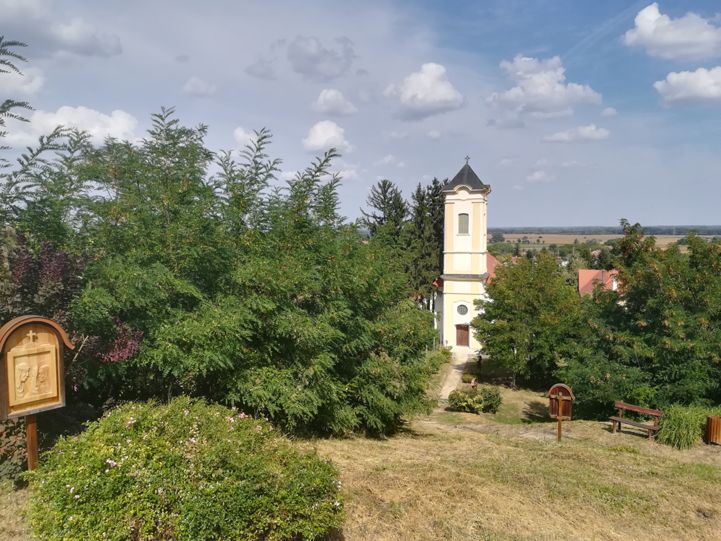
Táp
Táp, with a current population of nearly 1000, is one of the treasures of Hungarian folk architecture. On the slopes of the Táp vine hill is a unique monumental folk architecture ensemble, unique even on a national level. In Hegysor, a whole row of houses has been preserved in its 18th century original. All the houses are thatched-roof buildings. All of them are made of material quarried from the hillside and have tilted walls. Their windows are small and their porches open. Their roofing is thatch. These houses were occupied by landless peasants. They were people who did not own land, so they worked on the farms for cash or wages paid in crops. The houses on Hegysor Street are not only a reminder of the way of life of the 18th century peasants who lived here, but also of every day of our thousand years since the conquest. This type of house - room-kitchen-chamber - is not very different from the houses that have been excavated from the Árpád period. The Hegysor complex consists of 11 plots. The earliest building dates from 1792 and the youngest from the mid-19th century. The open-air museum, made up of farmhouses built in the 18th and 19th centuries, is a registered heritage site and the streetscape is protected as a monument. Every year, the Hegysor Spring Festival is organised, which has become the most important folk art event in the region. Hegysor Street in Táp has become emblematic of the village: paintings of Hegysor houses hang on the walls of the municipality's offices, and the Hegysor landless peasants' houses adorn the Táp coat of arms and the main page of Táp’s website.
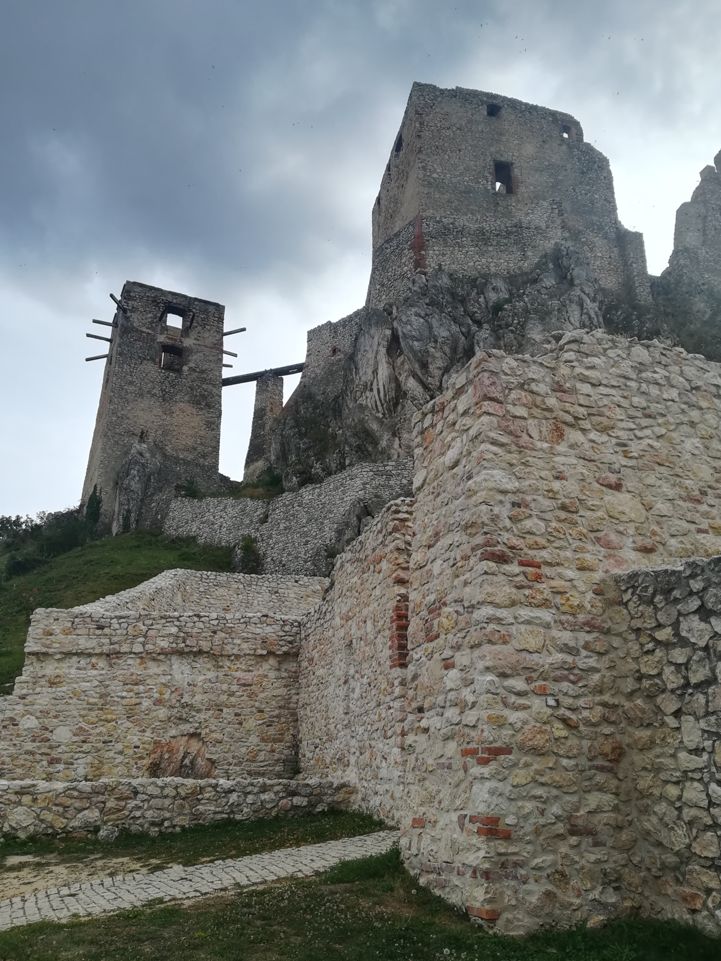
Castle of Csesznek
Bakonyszentkirály, with a population of just over 800, is named after King St Stephen, the patron saint of the country. The castle, which is regularly used as a set for Hungarian and foreign films, can be seen in the village. The fortress is the birthplace of the great era of castle building following the Tartar invasion of 1241-42. The first castle was built around 1263 on a rocky peak suitable for defence by the royal sword-bearer Jakab Cseszneki of the Bána noble family. The first mention of the castle is found in a charter of 1281, according to which the sons of Jakab used the castle together. In 1315, the Csák nation occupied the castle, but in 1323, the country judge Lampert granted the property back to Mihály Cseszneki and his son János Cseszneki. However, they sold it to the Csák clan for Pázmándfalu and 100 silver denarii later that year. In the 14th century, King Károly Róbert annexed the area, which abounded in game, to the imperial estates. In 1392, King Sigismund of Luxembourg ceded the castle of Csesznek to the noble family of Garai, together with the thirty-one villages belonging to its domain. The initially small castle was rebuilt considerably by the Garai family. The transformation of the castle into a Gothic knight's castle was completed in 1424, by which time the inner part, surrounded by multiple defensive walls, had been built. Its heyday can also be dated to the 15th century. The castle remained in the possession of the Garai family until 1482. King Matthias donated it to his treasurer, István Szapolyai in 1483. It was occupied by King Ferdinánd I in 1527, thus it fell into foreign hands. Csesznek and its estate were acquired by Pál Bakics, who possessed them until his death in 1537. The castle was also briefly in the hands of Bálint Török, then in 1540 it was given to István Csaby, who was the chief captain of Eger. Later it passed into the hands of the Csaby-Wathay families. By the middle of the 16th century, the conquering Turks had invaded Transdanubia, where Csesznek – under the leadership of Lőrinc Wathay, the castle captain – defended the country as a fortress. Wathay's life was cut short by a tragic accident: in 1573, drunk on wine, he was about to fire an old gunpowder-filled cannon in a fit of joy, but the soldier standing next to him was reluctant to do so. Captain Lőrinc snatched the torch from his hand and lit the fuse. The gun exploded with a huge bang, killing them both. By 1594, the castle had fallen into Turkish hands, but was recaptured in 1598. At the turn of the 16th and 17th centuries, the castle belonged to the Cseszneky family. In 1605, it was conquered by István Bocskai's troops, and in 1619 by Gábor Bethlen's military leaders, György Haller and Péter Fekete. It became royal property again after the Treaty of Nikolsburg in 1622. During the Rákóczi War of Independence, the castle was used as a storehouse for ammunition and food, as well as a prisoner-of-war camp. In 1708, the imperial armies besieged it in vain, but managed to take it in 1709. In its 500-year history, the castle has changed hands at least ten times. After the war, the role of the castle changed, and the Esterházy counts transformed the grim stone castle into a baroque mansion offering comfortable accommodation. According to contemporary sources, the noble family moved out in 1780, but the servants still used the rooms, which were rendered uninhabitable by an earthquake and then a fire thirty years later. The 1967-69 excavation succeeded in gathering information on the 13th century condition of the castle, although the ruins that were found are roughly 16th century.
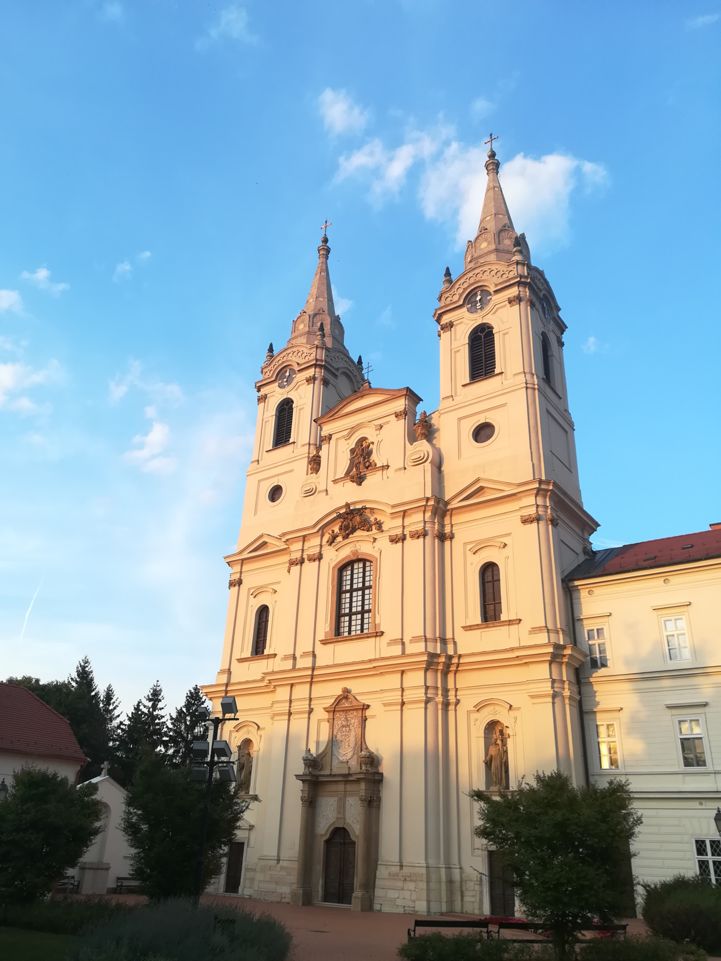
Abbey Church
Zirc, with a population of over 7000, is the highest town in Hungary. Its foundation dates back to 1182, when the first Cistercian monks appeared in the Bakony at the invitation of King Béla III of Hungary. The building of the abbey church was started in 1732 by Cistercian monks from Heinrichau in Silesia. They also used medieval buildings that were in a dilapidated state at the time. The new abbey was consecrated in 1752. The main altar of the church, which is of exceptional beauty and of national importance, is the largest Baroque altarpiece in Hungary. The church also boasts two paintings by Franz Anton Maulbertsch, one of the most important artists of the time. The two organs of the church are unique: the sanctuary organ accompanied the monks' prayers, while the German Romantic instrument in the choir served and still serves the liturgy. Since the restoration was completed in 2005, the interior of the church has been restored to its original splendour. It is not only a monument, of course, but also a tourist attraction: the church, which was given the status of basilica minor in 1982, the eight hundredth anniversary of its foundation, is the liturgical home of a living community of monks. It is also the parish church of the town of Zirc. An exhibition of church and religious history has been set up in the former orange house of the abbey. Visitors can gain insight into the past and present daily life of the monks who have lived in Zirc for 800 years, with some interruptions. Members of the community talk about their vocation, their tasks and their lives. In addition to personal testimonies, the material relics also speak for themselves: artefacts, objects and liturgical works from the centuries of the abbey are exhibited in the various cases. The history of the Cistercian monks can be traced from the foundation of the abbey in 1182 to the present day, and the changes and development of the order's activities and tasks in Hungary. Interactive touch-screen information panels and audio guides help you find your way around. The Monument Library is located on the second floor of the abbey building. The first books were brought along by the monks who founded the monastery in the 18th century. By 1950, the collection had grown to 65,000 volumes and the library became state property after the dissolution of the Cistercian Order. The National Library was entrusted with its management, which it still performs today, while ownership reverted to the Cistercians. The library has 70 ancient prints and more than 300 antiquities, many of which are unique in Hungary. The collection is mainly theological, but there are also books on other scientific subjects. The library can be visited as a guided tour, during which guests can learn about the history of the Cistercian collection and the Order, as well as visit a book exhibition and the large hall with its inlaid decoration of European fame. The Zirc Arboretum is an English-style park in the historic setting of the Cistercian Abbey. The garden is situated at 400 metres above sea level and has the highest collection of trees in Hungary. It provides a splendid sight and a pleasant refreshment in all seasons. In spring, the lush sight of ornamental plants and perennial beds planted on the banks of the fish pond, in summer the thousands of shades of green, the sultry scent of the linden trees, the trickling of the Cuha stream, in autumn the warm brown-yellow colour of the garden, in winter the snow covering the branches and the frost will enchant the visitor. The 18-hectare "woodland garden" dates back to the second half of the 18th century, where visitors can often see the beetles and insects of the Bakony region in a beautiful natural setting. If you are lucky, you might even see deer or squirrels accompanying you on a walk in the garden. If you are feeling tired, you can quench your thirst with a beer from the Zirci Abbey Manufactory. The first Zirc beer was brewed for the convent in October 1735, but the tradition of brewing was only revived in 2015 - a duality of tradition and innovation makes their products unique in the market. Today, the abbey's beer is brewed in an authentic environment, using a combination of manual labour and the latest digital technology.
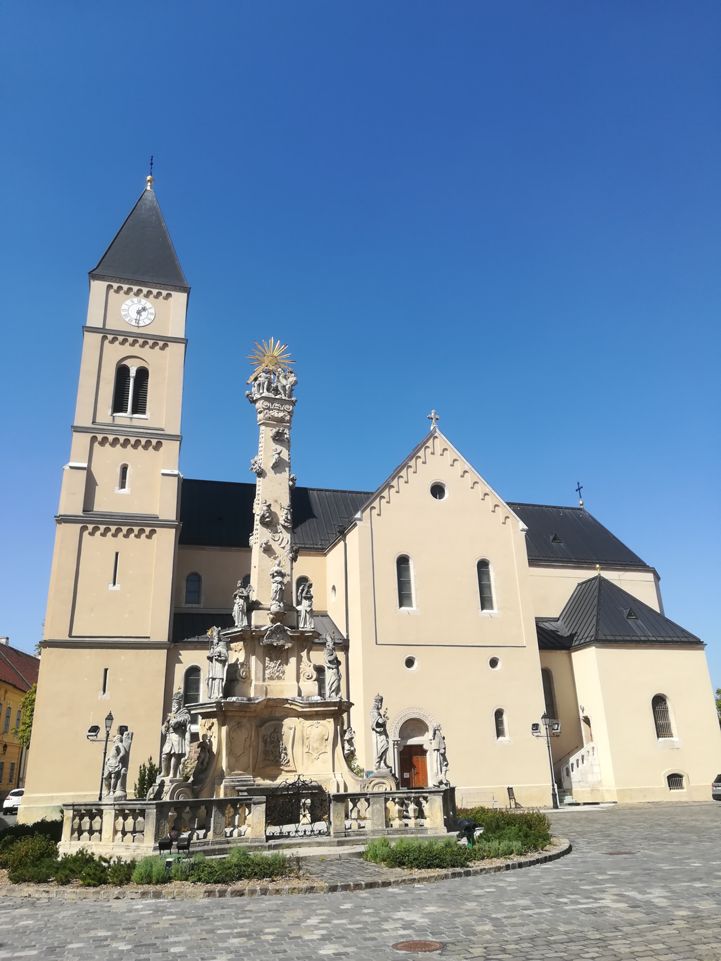
Veszprém
Veszprém, with a current population of 60,000, has a known history dating back almost seven thousand years. This is why it is often called the millennial city. Numerous rich finds from the Stone Age, Bronze Age and Iron Age have been unearthed in the area. In fact, Europe's oldest working mine lies nearby. The Romans established a villa farm on the outskirts of Veszprém. Here the Roman road to Italy and the Amber Road split. Later, the Longobard and Avar tribes occupying the Carpathian Basin settled in Veszprém. The origin of the town's name is still disputed. Some believe it comes from the Slavic word bezprem. This could mean uneven, hilly, referring to the surface features of the town. Others believe that it was named after the grandson of the founder of the Hungarian state, St. Stephen I. Veszprém also played an important role in the struggle for the introduction of Christianity among the shamanistic Hungarians: it was here that Stephen I defeated the armies of the rebel Koppány. The town became the seat of a bishop: the first in the country. The coronation robes of the founder of the state, St Stephen I, were made here. The queen was always the primary ruler of the area, and throughout history the city has been known as the city of the queens. There are many questions about the origins of the castle, but it is certain that Veszprém Castle was one of our earliest castles. Some kind of fortification or church was probably already standing on the site of today's St. Michael's Cathedral in the 9th century, at the time of the Hungarian conquest. The written history of Veszprém, with its very colourful history, began at this time. The settlement, founded in a strategically excellent location, has changed hands every 50 years on average throughout its history: sometimes it was in the hands of the Turks, sometimes the Habsburgs, sometimes the Kingdom of Hungary. Its population and its territory have also changed constantly. The castle district, with its picturesque Baroque and neoclassical palaces, covers an area of approximately 400 x 100 m and is home to numerous ecclesiastical, scientific and artistic institutions, and is a busy tourist destination. In the castle area you can find the Gizella Chapel, the oldest building in Veszprém, the 40-metre-deep Castle Well in front of it, and the almost 50-metre-high Fire Tower. The whole area around it was destroyed over the centuries, but the tower still stands today.

Kálmán Kittenberger Zoo and Botanical Garden
Veszprém Zoo is Hungary's largest rural zoo with a long tradition. It bears the name of the famous Hungarian zoologist, hunter, writer and explorer of Africa. The zoo, with its unforgettable experience for young and old alike and its unique natural features, opened on 1 August 1958 and was built in just five months, thanks to a huge social effort. The zoo's most famous inhabitant at the time was Böbe the chimpanzee, whose ingenuity and playfulness made her one of the country's best-known animals; she could even paint and starred in several films about her. She died in 1970, and her wooden portrait and the Education and Exhibition Centre named after her are preserved in the zoo. Böbe's grave is also located here. The zoo consists of two parts: the Fejes Valley and the nearby Gulya Hill. In the picturesque Fejes Valley area, you can see traditional zoo animals such as exotic big cats, black bears and brightly coloured waterfowl. There are also curiosities such as playful Madagascar prosimians, unique baboons, a giant spurred tortoise, ever curious coatis and adorable little pandas. The Fejes Valley is also home to the children's favourite, the individually designed and built Kid’s Jungle Playhouse and Terrarium. Here, they can crawl, climb, try the Sloth Trail and climb into an animal crate. They can also relax in the parrot club or slide down an indoor slide. The play area is flanked by terrariums where visitors can see the special reptiles through glass walls. One of the most beautiful and largest African savannah enclosures in Hungary is located in the upper part called Gulya-domb (Herd Hill), where visitors can admire zebras, giraffes, impalas and a family of five square-lipped rhinos. The Monkey House, a unique complex in Europe in terms of its design and theme, was built next to the savannah enclosure, and is currently home to ring-tailed lemurs, baboons and mantled guerezas. In the inner space, only a glass wall separates visitors from the animals, and a moat lines their vast outdoor enclosure. Its inhabitants are goldfish and turtles brought in by visitors. The Elephant Park is home to three young and playful elephant bulls, Nuka, Dinkar and Félix. There is also a wetland wildlife project, where you can have a look at the lives of seals and African penguins. There is also the new rhino house and the associated enclosure, where visitors can admire their favourites in winter. Llamas have been given a place in the spectacle enclosure. The Flying Bird Enclosure was inaugurated in 2015, with a floor area of 5,000 square metres and a ceiling height of 15 metres. It is unique in Hungary, with flamingos, scarlet ibises and ducks. The Dino Park has been created recently in the Gulya-domb garden section, where visitors can learn about the world of dinosaurs through life-size dinosaur sculptures. These services were later extended to include hands-on activities in the Dinosaur Park, designed to introduce children to the work of archaeologists in a playful environment, while providing them with a wealth of new and interesting information about the fauna of our planet hundreds of millions of years ago.
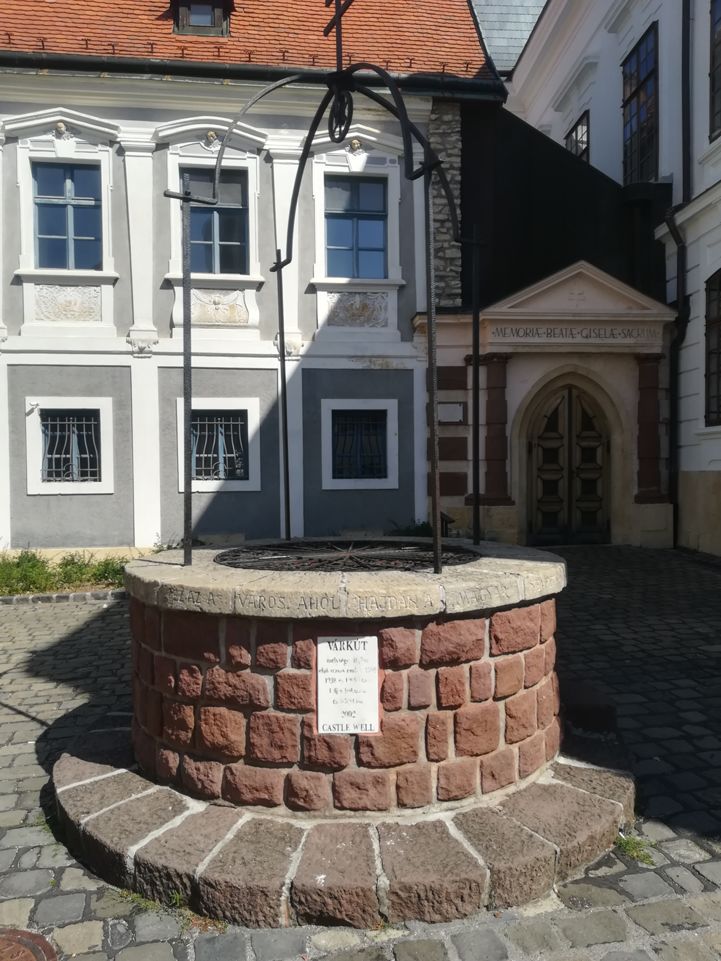
Castle well
You can find the castle well, formerly known as the "Dragon Well" in the Szentháromság Square in Veszprém, at the centre of the castle. Although it only appeared on a map in 1569, it is suspected to have been built much earlier, at the same time as the castle. Like all castle wells, this one had many legends, including that it had a tunnel leading out of the castle and that it hid treasures. The Veszprém Castle well has not been used since 1767, when the bishopric had a water-drawing structure built at the Úrkút spring under the castle. From then on, they started to fill it with rubble. In 1936, it was given an ornately carved rim. The first attempt to clean it was made in 1964-65, when they reached a depth of 30 metres, but it was not clear whether it was a well or a cistern (a water reservoir dug into rock). The well has recently been fully explored and cleaned up, as a result of an exemplary team effort: nearly 100 companies, institutions and non-governmental organisations participated in the exploration or supported it. The excavation lasted 18 days and resulted in reaching the bottom of the well at a depth of 40.7 metres. No other well of this depth has ever been excavated in Hungary. The preparation and execution of the work in the well required a great deal of expertise. It was also necessary to manage the removal of the debris, the protection of the people working at the bottom – there were always two of them down at the same time – and ventilation. The excavation of the last few metres was particularly difficult, as water had to be pumped out of the well continuously. No fabulous treasures have been found in the well, but there are numerous archaeological finds. In the top half metre, a lot of "lucky" coins, about 250 kg thrown in by tourists, were collected. Further down, they found old wooden parts (which may have been part of the former shingle-covered wooden well house), nails, a tin plate, a gold medal, earthenware flasks, fragments of pottery and glass, bone knob and fragments of a pottery pipe. There were also stone carvings, copper coins, horseshoes and candlesticks, but the most valuable find was a 17-metre-long hand-forged chain. At 40.7 m, the bottom of the well was reached, where karst water with a yield of 1-2.5 litres per minute was found. This supplied water to the well, which today still holds 3.5-4 m of water, solving one of the mysteries. The well was a real well, not just a water-collecting pit. Unfortunately, the excavation also put an end to the legend of the secret tunnel leading out of the well: nothing of the kind was found. So we lost a legend, but gained a wealth of knowledge.
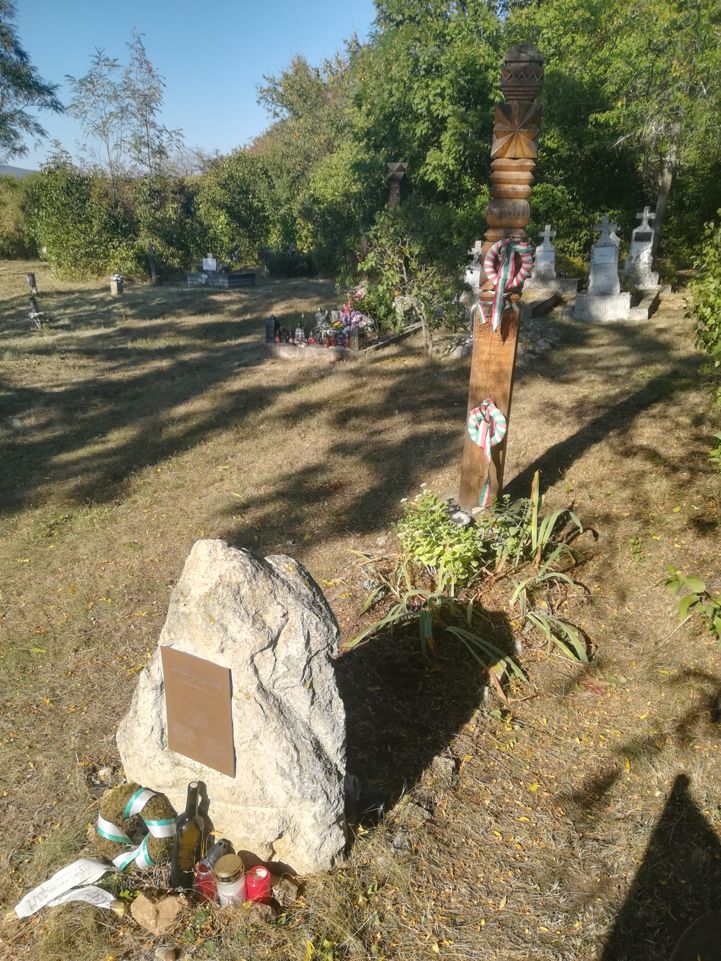
The Grave of Jóska Savanyó
Tótvázsony, today a settlement of 1200 inhabitants, is several hundred years old, dating back to the Árpád era. Its name was mentioned in a charter as early as 1082 under the name Touthwasun. The grave of Jóska Savanyó is in the local cemetery. Jóska Savanyó was born in 1841. His father was a head shepherd in Veszprém County, and Jóska himself started his life as a shepherd, but was not attracted by respectable poverty. He was forced to go into hiding for stealing sheep, and in 1860 he was imprisoned for eight months in the Veszprém prison for armed vagrancy. Within a couple of years, he was wanted for robbery, in 1872 he was arrested again, but nothing could be proved against him, and in 1875 he served a month for aggravated assault. His 'heyday' was between 1878 and 1884, when he and his gang committed one robbery after another in the counties of Vas, Zala and Veszprém. He was not picky, he took honey, cows and money, he beat his victims heavily and sometimes even tortured them. In 1881, he was already involved in murder, shooting a landowner with his men during a failed robbery attempt. The bandit became increasingly daring, robbing the manor treasury in Nagyvázsony in broad daylight. The authorities could not locate him for a long time, and the short Jóska Savanyó successfully hid in the Bakony mountains. In December 1883, 120 gendarmes were sent to the area to catch him, a 1000 Forint reward was put on his head, and the Ministry of the Interior declared martial law in Veszprém County. However, the outlaw's fate was not caused by this, but by a desire for revenge. Jóska was turned in by a shepherd helper, whose relative was shot dead by the bandit. In a manner worthy of a romance novel, his aggrieved friend mixed sleeping pills into the wine of the bandit, who was in high spirits in a tavern in Haláp, and the gendarmes were then able to easily subdue him. When his case was tried in 1886, the 27 charges included two counts of manslaughter. The last Hungarian outlaw, who spoke five languages - Hungarian, German, Tót (Slovak), French and Italian - spent 20 years behind bars, and was well past the age of 60 when he was released. For a short time he was shown as a spectacle in a café in Pest, then he opened a tailor's shop. He was only able to enjoy a year of freedom: he suffered from severe rheumatism and his leg was to be amputated, but he escaped the pain and the operation to his death on 9 April 1907. He was buried in Tótvázsony, where his grave is a tourist attraction. He was the inspiration for stories of outlaws and folk songs.
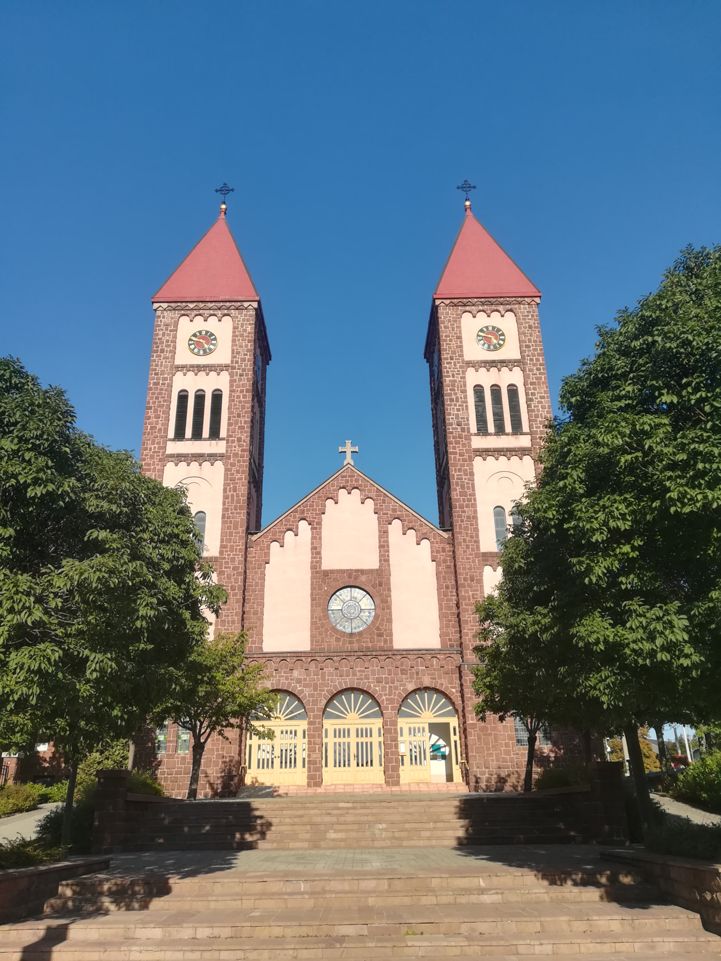
Balatonfüred
The settlement of 12 000 inhabitants is the "capital of the northern shore of Lake Balaton" and the oldest resort on the shore. Its fame and popularity are due to its proximity to Lake Balaton, its carbonic springs and its Mediterranean climate. Füred was declared Hungary's first spa and resort town. The area of Füred was already inhabited by prehistoric man. The Romans were its first known inhabitants, and their memory is marked by numerous excavated ruins and tombs. The first written record of Füred dates back to the 13th century. Large-scale development came in the 19th century, during the so-called Hungarian reform era. Writers, actors and noblemen of the time settled here or came for meetings. It was here that Count István Széchenyi, or as history calls him, ‘the greatest Hungarian’, launched the first steamboat on Lake Balaton. Mór Jókai, one of the best known and most respected Hungarian writers, wrote countless historical novels in his villa. Many heart patients, including Nobel Prize-winning Hindu poet Rabindranath Tagore, have recovered at the city's State Heart Hospital. Tagore arrived at the sanatorium on 1 November 1926 and planted a tree to celebrate his recovery. Tree planting became a tradition in a few years, and Nobel Prize-winning scientists and famous personalities who have visited the park have since planted trees in the park. Balatonfüred is "the international city of grapes and wine". In August, the centre of the promenade is occupied by the tents and benches of the Wine Week, and the promenade is lined with fire pits, street musicians including a Peruvian band, live sculptures, artists and mobile vendors. This is where the most prestigious sailing race on Lake Balaton, the Kékszalag (Blue Ribbon), starts and returns. The Blue Ribbon is the biggest celebration of Lake Balaton and sailing, and the biggest event of the Hungarian Sailing Federation. The Blue Ribbon is the symbol of sailing in Lake Balaton. Its participants face both opponents and the challenges of the weather, testing their sailing skills, endurance and willpower over two days.
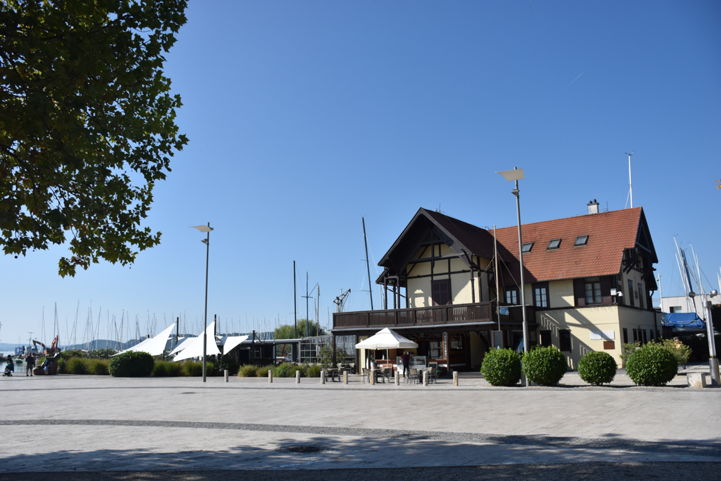
”Vitorlázeum” Sailing Museum
A unique, interactive exhibition space of sailing history awaits visitors in one of the most prestigious buildings of Balatonfüred, on the first floor of the first clubhouse of Balaton sailing. The new exhibition, open all year round, not only enhances the tourist offer of the town, but also has a special and innovative theme, making it a unique attraction for tourism in Balaton. Using modern IT tools, it offers a rich experience for all ages. In the exhibition space presenting the history of sailing on Lake Balaton in a playful and visual way, the usual display cases are replaced by various experiential elements. A simulator allows you to try sailing in the stormy Lake Balaton, learn how to navigate and tie ropes. You can practice hoisting the sail or enjoy the panoramic view from the terrace surrounding the exhibition. Visitors can learn about the history of sailing on Lake Balaton, the famous boats and sailors of the lake in an easy and entertaining way, with audio and visual material, a touch-screen information system, a spectacular interactive map of Lake Balaton, films about the harbours, binoculars and multilingual digital guided tours. In the Balaton Room, the intelligent visitor recognition system helps you to learn about the history of sailing on Lake Balaton and the different eras of sailing. Each numbered frame on the touch-screen panel contains a video that starts when you step on it. The information leaflet you receive on entry includes the titles and themes of the 40 short films, so you can browse through the past and present of sailing at your leisure. A so-called pool table offers creative activities for children: they can make small sailboats and try them out in the pond of the activity table. The ‘Room of Beginnings’ presents the beginnings of sailing on Lake Balaton, with the help of photos and objects, which are arranged in tables and provide interesting information for the visitors. You can browse through the books hanging on the original pieces of the Tramontana, the boat that has won the most Blue Ribbon victories, and practice hoisting the ropes to gain an insight into the history of the building and shipbuilding, which dates back to 1867. In the ‘Touring Boats’ Room you can get to know the types of tour boats used at Lake Balaton. The tables show the descriptions and uses of the boats, as well as models of tour boats with their descriptions. In the ‘Competitive Boats’ Room, you can compare touring boats with racing boats by looking at the descriptions of the types. The ‘Blue Ribbon’ Room is a room dedicated to the history of the famous Blue Ribbon sailing race, its operation and its rules: the displays showcase objects, documents and descriptions of the winning boats. It is also home to the media boxes, which allow visitors to watch longer, full-length narrated versions of the short films that are shown in the Balaton Room. Games on the ‘Experience Terrace’ offer an insight into the world of water sports on Lake Balaton. You can experience, for example, "Surfing on dry land" and mooring, but you can also learn how to steer and control sailing boats with the game "Turn the wheel".

Balatonfüred
The area around Balatonfüred, which today has 13 000 inhabitants, was already inhabited in prehistoric times. Its first known inhabitants were the Romans. Their memory is preserved in numerous archaeological finds, ruins and tombs. The first written record of Balatonfüred dates back to the early 13th century. From the 18th century onwards, its acidulous water was well-known, and was soon declared to be a medicinal water. At that time, it already had a bathhouse suitable for receiving guests. By the 19th century, Balatonfüred had become a popular cultural centre, an elegant resort and spa. With its lively social life, it was a popular meeting place for the elite of the time, and the Balatonfüred Theatre provided light summer entertainment for the guests staying here. Soon the first Anna Ball was held in Füred, which has been organized every year since. The Anna Ball series is now almost 200 years old. With the support of Count István Széchenyi, the ’greatest Hungarian’, the first steamboat was launched from here in the middle of the 19th century. Everyone who could afford it, built a private villa here. Soon the promenade in Füred was developed, the construction of the State Cardiac Hospital and Sanatorium began, and the Stefánia Yacht Club sailing club was founded. After World War II, a campsite with a capacity of 4 000 people was completed. By the 20th century, Balatonfüred had officially become the "International City of Grapes and Wine". Many patients, including the Nobel Prize-winning Hindu poet Rabindranath Tagore, have regained their health in the state-run Cardiac Hospital, which is still in operation today. The famous poet came to the sanatorium in the early 20th century. To celebrate his recovery, he planted a tree on the promenade. According to a Hindu legend, if you plant a tree in old age, you will live to see it grow lush foliage. In front of the tree, a bronze statue of Tagore was unveiled by an Indian delegation in the middle of the 20th century. Since then, the promenade has also borne his name. Tagore was first followed by Indian politicians. In a few years, it has become a tradition for famous personalities to plant a tree in the park. The most notable and most visited churches in Balatonfüred are the Catholic Red Church (Vörös Templom), the Reformed white church and the Round Church (Kerektemplom) in the centre of the Fürdőtelep. The Red Church takes its name from the red stone, which is typical of the area and can no longer be mined. In front of the harbour you can see the statues of the Fisherman and the Ferryman. Legend has it that anyone who strokes their boots is sure to return here. Well, you can't complain about the shine on the boots...

The Roman Catholic Church of Christ the King
The Roman Catholic Church of Christ the King, colloquially known as the Red Church, was built in the early 20th century in neo-Romanesque style. Its two 35-metre towers are a dominant symbol of the city. The first written records of the parish date back to the 14th century. Unfortunately, the parish of Füred was completely destroyed during the Turkish period. The Catholic inhabitants either fled or were victims of the fighting. By the middle of the 18th century, only seven Catholic families remained in the town. But faith and strong will did their part. The foundation stone of the red church was laid at the beginning of the 20th century. The neo-Romanesque church was completed quickly, even for the average speed of construction at the time. The two 35-metre towers were the last to have the crosses installed. The church in Füred was consecrated in honour of Christ the King. The mass altar depicts the Last Supper. On the reading stand is a carving of St John the Baptist. In the pulpit, four carvings related to doctrine can be admired. These are the Ascension of Jesus Christ, Pentecost, the Miraculous Draught of Fish and the Sermon on the Mount.
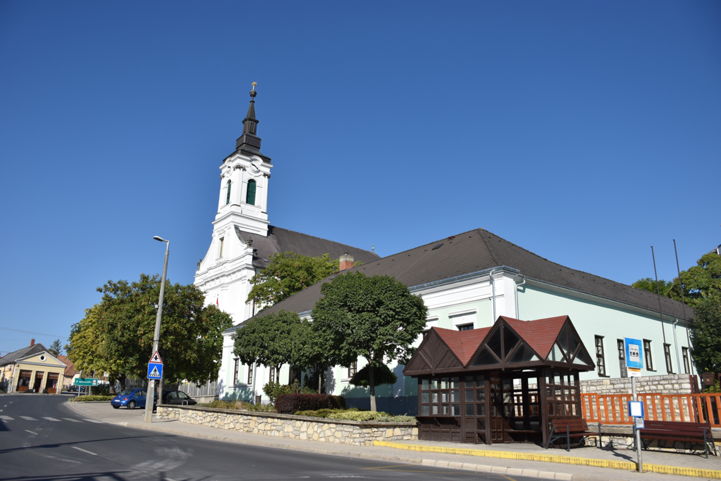
Reformed parish church of Balatonfüred
With the spread of Reformation, part of the population of Balatonfüred converted from the Catholic faith to the "new faith". By the middle of the 16th century, the congregation of Balatonfüred already had its own Reformed Church pastor. The first church building of the Reformed Church parish of Balatonfüred stood on the site of the Catholic church dedicated to St. Margaret, which had been completely destroyed. However, even after several rebuildings and extensions, the church building was still not big enough for the congregation of the time. It was decided that a new Reformed church should be built. The foundation stone of the present church was laid in the early 19th century. The costs of its construction and furnishing were contributed by the members of the parish in money, labour and wine. At that time, the craftsmen also requested Füred wine in addition to the money. The church was consecrated on 1 August 1830. This was followed by the construction of the neo-Romanesque red marble baptismal font. The organ was built with public donations and consecrated at the end of the 19th century. The church underwent a complete interior and exterior renovation for its 100th anniversary. Of course, minor and major repairs were needed later on. Nevertheless, the church building, including its furniture, is still visible in its original form. The words of the Grand Prince Gábor Bethlen have guided the community's path so far and will continue to do so in the future: "If God is with us, who is against us?"
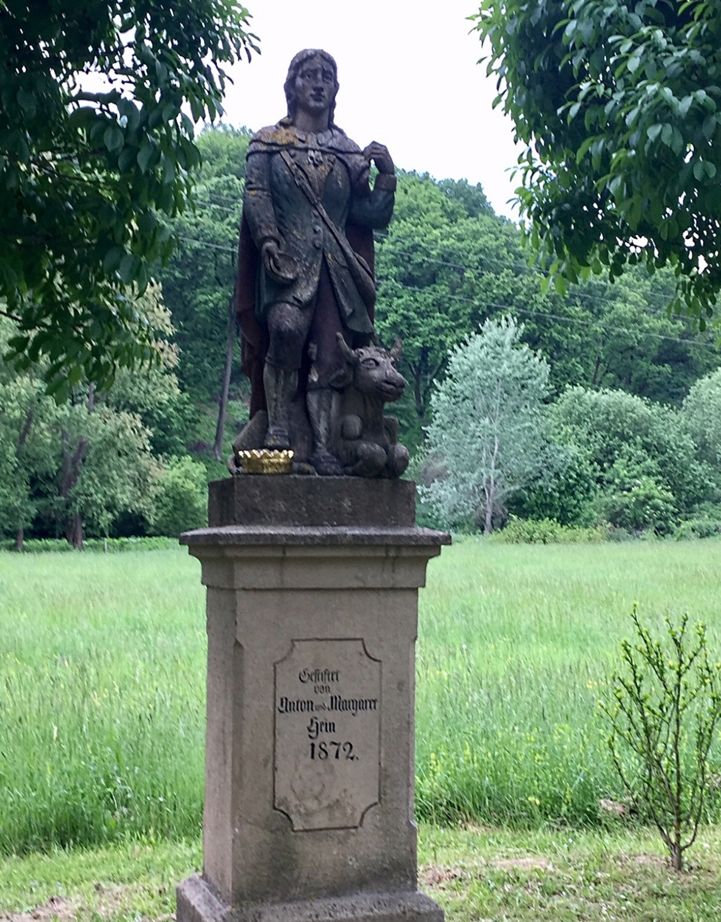
Statue of Saint Wendelin
The statue of St Wendelin stands along the road leading to the east, out of the village of almost 400 inhabitants. The monument to the patron saint of shepherds is a reminder of the pastoralism and animal husbandry that played a major role in the old days. His veneration, traditional in German-speaking areas, was brought to our country by the German settlers. Legend has it that Prince Wendelin was the son of a tribal leader. He was born with the desire to become a hermit. His father tried to dissuade him, but he was unsuccessful. Despite all the trials and tribulations, Wendelin persevered in his desire. In this he found companions on his journey. They built a hut far from the city and kept a strict fast and prayer. Once they had to beg, and the farmer scolded Wendelin for idling instead of working. So Wendelin went to live with the farmer as a shepherd. Every day he searched for the best pasture, he roamed the hills with his flock, and his heart yearned for his hermit-cell. His desire was so pleasing to God that he sent angels who lifted up Wendelin and his flock and took him to his cell. But there was no water there to water the animals. Wendelin began to pray for water. When he stuck his shepherd's crook into the ground, a spring sprang up. His master, who had scolded him harshly for taking the cattle so far, was riding there. Wendelin promised to be home at the usual time. The farmer himself could not believe that when he returned home with his horse, Wendelin and the cattle were already there. At the sight of this miracle, he dismissed him, because he realised that a hermit's life was not a life of worklessness. Wendelin returned to his cell, but he was not long alone. The hermits who had settled around him elected him their magistrate as a mark of respect. Legend has it that during Wendelin’s lifetime they built a monastery and elected him abbot of the Benedictine community. He died in 617.